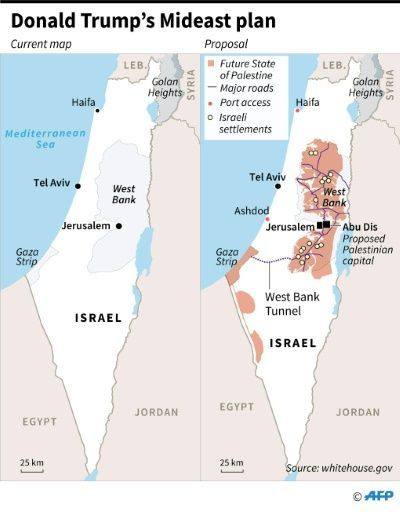Peace between Israel and Palestinians living in the Biblical heartland of Judea and Samaria, known as the West Bank, has been elusive for 75 years. On Tuesday President Donald Trump released a peace plan as ambassadors from three former enemies of Israel stood in a show of support. This while Palestinian representatives boycotted the announcement.
To the surprise of some, and delight of many, the United Arab Emirates, Oman and Bahrain attended the announcement.
The long-awaited Middle East peace plan was two years in the making and the blueprint, aimed at resolving the decades-long Israeli-Palestinian conflict, for the first time revealed a map of what a future Palestinian state would look like.
VIDEO: Watch the announcement
Trump said the 80-page plan represented a “vision for peace, prosperity, and a brighter future for Israelis and Palestinians.” He said it’s “fundamentally different from past proposals.”
“This is an unprecedented and highly significant development,” he said at a White House event with Israeli Prime Minister Benjamin Netanyahu.
“What he has achieved is quit extraordinary,” Netanyahu told Fox News on Wednesday. “The Arab states, instead of going back to the status quo of total support for Palestinians at any cost, said to the Palestinians ‘you should negotiate under American auspices.'”
Netanyahu’s observations about Palestinian leaders is accurate as under the Trump administration, Arab nations in the Gulf, including Saudi Arabia, have more recently sided with Israel in the conflict. After billions of dollars in aid that has been mismanaged by Palestinian leaders, Arab nations now see the future as one that incorporates Israel as a reliable partner against Iran that could bring peace and prosperity to the region.
Trump released the plan to unanimous applause in a room packed with State Department officials, US and UN ambassadors and ambassadors from other nations.
“In the past, even the most well-intentioned plans were light on factual details and heavy on conceptual frameworks,” he said. “My vision presents a win-win opportunity for both sides, a realistic two-state solution that resolves the risk of Palestinian statehood to Israel’s security.”
The plan is only the first step for progress toward peace and includes a conceptual map outlining the two states.
According to the plan, “Israel has agreed to a four-year land freeze to secure the possibility of a two-state solution.”
“Jerusalem will stay united and remain the capital of Israel, while the capital of the State of Palestine will be Al-Quds and include areas of East Jerusalem,” the plan states. Al-Quds is the Arabic name for Jerusalem.
“This map will more than double the Palestinian territory and provide a Palestinian capital in eastern Jerusalem where America will proudly open an embassy,” Trump said.
After the meeting, Trump posted a map on Twitter showing the future of the Palestinian state.
‘Greatest Friend’ of Israel
Speaking at the event, Netanyahu praised Trump, calling him “the greatest friend that Israel has ever had in the White House.”
While many past plans “tried to pressure Israel to withdraw from vital territory,” he said, Trump’s blueprint recognized Israeli sovereignty in disputed territories, including the Jordan Valley and other Jewish settlements in the West Bank in the areas known as Judea and Samaria.
According to the plan, nearly 30 percent of the West Bank would be allocated to Israel, which is the territory that Israel seized from Jordan in the 1967 Arab–Israeli war.
The proposal gives Palestinians a path to a future state that will cover the remaining 70 percent of the West Bank and the Gaza Strip. But the plan goes even beyond what most expected in its generosity to the Palestinians. Israel will relinquish its own land, virtually doubling the amount of territory Palestinians currently control. Israel will give Palestinians huge areas of land near Gaza and south of the West Bank to relieve Gaza’s overcrowding. It is basically a land swap.
It also “provides for a high-speed rail connection between Gaza and the West Bank,” as both are geographically separated, David Friedman, U.S. Ambassador to Israel, told reporters.
The plan also calls for Hamas to be disarmed and for Gaza to be demilitarized.
“Regardless of the Palestinian decision, Israel will preserve the path of peace in the coming years,” Netanyahu said.
“At the same time, Israel will apply its laws to the Jordan Valley, to all the Jewish communities in Judea and Samaria, and to other areas” that the plan designates as part of Israel, he said.
The Palestinian leadership, which had earlier rejected the plan, was not invited to Washington. Palestinians earlier made clear that they would reject Washington’s role as mediator in the conflict.
“Trump, Jerusalem is not for sale. Our rights are not for sale. Your conspiracy deal will not pass,” Palestinian President Mahmoud Abbas said on Jan. 28 in response to Trump’s proposal, according to Israel’s daily newspaper Haaretz.
“After the nonsense that we heard today we say a thousand no’s to the Deal of The Century,” he said. “Trump and Netanyahu declared the slap of the century, not the deal. And we will respond with slaps.”
Palestinians earlier described the plan as “the plot of the century to liquidate the Palestinian cause” and threatened to withdraw from the 1993 Oslo Accords, which sought to construct peaceful Israeli–Palestinian relations.
Palestinians have been accusing Trump of siding with Israel after Washington recognized Jerusalem as Israel’s capital and moved the U.S. Embassy there. Trump also closed Palestinian diplomatic offices in Washington in September 2018, citing the failure of the Palestinians to enter into negotiations with the Israelis. The Trump administration also slashed funding to Palestinian aid programs in August 2018, with one of the main reasons being concern over the terror group Hamas ruling Gaza.
Kushner-Led Peace Plan
A team led by Trump’s son-in-law and senior advisor Jared Kushner was in charge of crafting the peace plan. Kushner last year revealed the economic portion of the peace plan, promising to invest $50 billion to help Palestinians and neighboring Arab states if a peace deal with Israel was accepted.
David Makovsky, a former State Department adviser on Israeli–Palestinian negotiations and senior fellow at The Washington Institute said that the Trump plan would fall considerably short of Palestinian expectations.
“If Trump is reelected, the administration believes the Palestinian Authority would need to swallow its defiance and reconcile itself to this new political reality,” he wrote on Jan. 24 in a report.
Before the event, Trump invited both Netanyahu and Israeli opposition leader Benny Gantz to the White House. He held separate meetings on Jan. 27 with each leader to disclose the details of his plan and discuss major bilateral issues between the United States and Israel.
The separate meetings with Netanyahu and his main rival Gantz reflected Israel’s upcoming tense election. Having failed to form a majority coalition in Parliament after two general elections in 2019, Israel is heading to an unprecedented third election on March 2.
Trump said that he received backing for his plan from both leaders, adding that “peace transcends politics by any measure.” The announcment and plan also came with the blessing of Arab Gulf states.
–Metro Voice and wire services







